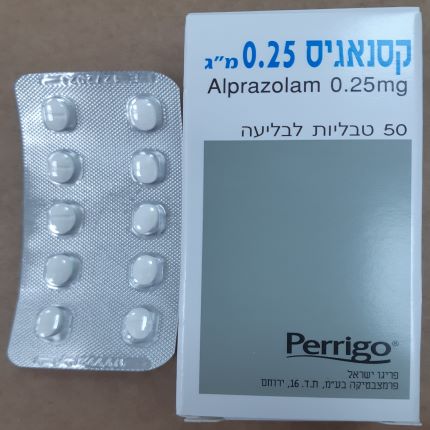Quest for the right Drug

קסנאגיס 0.25 מ"ג XANAGIS 0.25 MG (ALPRAZOLAM)
תרופה במרשם
תרופה בסל
נרקוטיקה
ציטוטוקסיקה
צורת מתן:
פומי : PER OS
צורת מינון:
טבליה : TABLETS
עלון לרופא
מינוניםPosology התוויות
Indications תופעות לוואי
Adverse reactions התוויות נגד
Contraindications אינטראקציות
Interactions מינון יתר
Overdose הריון/הנקה
Pregnancy & Lactation אוכלוסיות מיוחדות
Special populations תכונות פרמקולוגיות
Pharmacological properties מידע רוקחי
Pharmaceutical particulars אזהרת שימוש
Special Warning עלון לרופא
Physicians Leaflet
Interactions : אינטראקציות
DRUG INTERACTIONS Drugs Having Clinically Important Interactions with Xanagis Table 4 includes clinically significant drug interactions with [see Clinical Pharmacology]. Table 4: Clinically Significant Drug Interactions with Xanagis Opioids Clinical implication The concomitant use of benzodiazepines and opioids increases the risk of respiratory depression because of actions at different receptor sites in the CNS that control respiration. Benzodiazepines interact at gamma- aminobutyric acid(GABAA) sites and opioids interact primarily at mu receptors. When benzodiazepines and opioids are combined, the potential for benzodiazepines to significantly worsen opioid-related respiratory depression exists. Prevention or management Limit dosage and duration of concomitant use of Xanagis and opioids, and monitor patients closely for respiratory depression and sedation [see Warnings and Precautions]. Examples Morphine, buprenorphine, hydromorphone, oxymorphone, oxycodone, fentanyl, methadone, alfentanil, butorpenol, codeine, dihydrocodeine, meperidine, pentazocine, remifentanil, sufentanil, tapentadol, tramadol. CNS Depressants Clinical implication The benzodiazepines, including alprazolam, produce additive CNS depressant effects when coadministered with other CNS depressants. Prevention or management Limit dosage and duration of Xanagis during concomitant use with CNS depressants [see Warnings and Precautions ]. Examples Psychotropic medications, anticonvulsants, antihistaminics, ethanol, and other drugs which themselves produce CNS depression. Strong Inhibitors of CYP3A (except ritonavir) Clinical implication Concomitant use of Xanagis with strong CYP3A inhibitors has a profound effect on the clearance of alprazolam, resulting in increased concentrations of alprazolam and increased risk of adverse reactions [see Clinical Pharmacology ]. Prevention or management Concomitant use of Xanagis with a strong CYP3A4 inhibitor (except ritonavir) is contraindicated [see Contraindications (4), Warnings and Precautions ]. Examples Ketoconazole, itraconazole, clarithromycin Moderate or Weak Inhibitors of CYP3A Clinical implication Concomitant use of Xanagis with CYP3A inhibitors may increase the concentrations of Xanagis, resulting in increased risk of adverse reactions of alprazolam [see Clinical Pharmacology ]. Prevention or management Avoid use and consider appropriate dose reduction when Xanagis is coadministered with a moderate or weak CYP3A inhibitor [see Warnings and Precautions]. Examples Nefazodone, fluvoxamine, cimetidine, erythromycin CYP3A Inducers Clinical implication Concomitant use of CYP3A inducers can increase alprazolam metabolism and therefore can decease plasma levels of alprazolam [see Clinical Pharmacology ]. Prevention or management Caution is recommended during coadministration with Xanagis. Examples Carbamazepine, phenytoin Ritonavir Clinical implication Interactions involving ritonavir and alprazolam are complex and time dependent. Short term administration of ritonavir increased alprazolam exposure due to CYP3A4 inhibition. Following long term treatment of ritonavir (>10 to 14 days), CYP3A4 induction offsets this inhibition. Alprazolam exposure was not meaningfully affected in the presence of ritonavir. Prevention or management Reduce Xanagis dosage when ritonavir and Xanagis are initiated concomitantly, or when ritonavir is added to a regimen where Xanagis is stabilized. Increase Xanagis dosage to the target dosage after 10 to 14 days of dosing ritonavir and Xanagis concomitantly. No dosage adjustment of Xanagis is necessary in patients receiving ritonavir for more than 10 to14 days [see Dosage and Administration ]. Concomitant use of Xanagis with a strong CYP3A inhibitor, except ritonavir, is contraindicated [see Contraindications, Warnings and Precautions]. Digoxin Clinical implication Increased digoxin concentrations have been reported when alprazolam was given, especially in geriatric patients (>65 years of age). Prevention or management In patients on digoxin therapy, measure serum digoxin concentrations before initiating Xanagis. Continue monitoring digoxin serum concentration and toxicity frequently. Reduce the digoxin dose if necessary. Drug/Laboratory Test Interactions Although interactions between benzodiazepines and commonly employed clinical laboratory tests have occasionally been reported, there is no consistent pattern for a specific drug or specific test.

שימוש לפי פנקס קופ''ח כללית 1994
לא צוין
תאריך הכללה מקורי בסל
לא צוין
הגבלות
לא צוין
רישום
063 48 26906 01
מחיר
0 ₪
מידע נוסף
